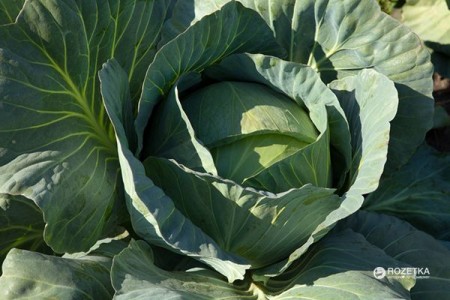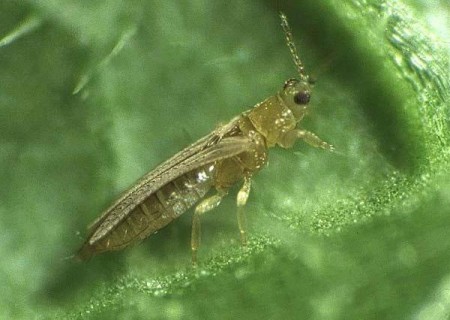“We had good cabbage this year. During the season, we treated it with hot pepper, mustard, and fed it with an ash solution, but still there were some defects.
- There are dry leaves in cabbage.
- Cabbage leaves with black spots.
- Several small heads of cabbage grew under the head of cabbage.
I would like to know why this could happen."
We will answer these questions in order of priority.
Dry layers in heads of cabbage
Dry leaves in a head of cabbage are the result of hot weather that occurred during the head setting phase. At high temperatures, the edges of young leaves dry out and become thin. As the head of cabbage grows, the dead leaves end up inside it and can only be seen by cutting the cabbage.
To avoid the formation of such defects, experts advise later planting cabbage seedlings in open ground, regularly watering, and not allowing the soil to become compacted. Foliar feeding with calcium nitrate helps. During hot periods, plants do not absorb this nutrient from the soil.
Where do black spots on cabbage leaves come from?
The reasons for the appearance of spots on leaves can be different. Gray or black, slightly depressed small spots of various shapes, most often appearing on the outer leaves of the head of cabbage, arise as a result of excess nitrogen nutrition and a lack of potassium, phosphorus, boron, and molybdenum.
Point necrosis (the so-called name of this non-infectious disease) makes itself felt if cabbage is stored for a long time at a temperature of +1+4 degrees. But both the first and second reasons for the occurrence of punctate necrosis have nothing to do with your cabbage: you did not feed it with nitrogen, and you have not yet had time to store the cabbage for a long time at the temperatures indicated above.
Therefore, with a high degree of probability we can say that the dots on cabbage leaves are the result of thrips activity. Rusty spots become noticeable after the heads of cabbage begin to “undress.” With severe damage, the leaves are affected almost to the very center of the head of cabbage.
It is difficult to notice thrips during the growing season.
- It can only be examined with a magnifying glass (the size of an adult insect is 2 mm)
- It does not form dense colonies like aphids
- The presence of thrips does not affect the appearance of cabbage: it grows and forms heads of cabbage. But in the fall or winter, having cut a beautiful head of cabbage, summer residents are perplexed: it’s completely unusable inside.
Tobacco thrips often thrive in our beds, causing significant damage to onions and white cabbage. In hot, dry summers, thrips can produce up to eight generations.
The pest can overwinter in storage facilities, from which in the spring it can return to the garden on seed plants (in particular, onion sets); reserved on weeds and plant residues. Already in early April, thrips begin to feed - first on weeds, and later gradually colonizes the beds.
The larvae appear within three days after the females lay eggs. Another ten days - and the larvae go into the soil, so that after a few days they turn into winged adult insects capable of dispersal. The hotter the weather, the faster thrips develop, the more harmful they are.
You can successfully fight thrips by knowing its habits and preferences. Thrips do not sit in one place like aphids. In the morning, in search of warmth, they move to the tops of the leaves, during the day they look for a cooler place, and in the evening they return to the base of the head of cabbage.
In autumn, thrips live and feed inside the head of cabbage all the time. And in general, this pest loves plants in which you can find secluded corners: cabbage, onions, gladioli. It actively develops on plants that are watered at the root, and does not like sprinkling watering.
The most noticeable damage is caused to late varieties of white cabbage and onions. Therefore, when growing them, it is necessary to observe crop rotation, deep digging of the soil, destruction of plant residues and weeding, irrigation by sprinkling, ensuring balanced nutrition, growing varieties resistant to thrips.
The last two elements require a little clarification. Already in the first period of development (10-12 days after planting seedlings), cabbage is fed not only with nitrogen, but also with potassium and microelements.
Let's say you watered the cabbage bed with an infusion of mullein, green grass (0.5 liters per 10 liters of water), do not forget to then sprinkle the wet rows with wood ash and loosen them. In August, nitrogen (even in organic infusions) should be abandoned in favor of wood ash or potash fertilizers.
A few words about thrips-resistant varieties. These include hybrids with a strong waxy coating and dense leaves, for example Aggressor F1.
When growing cabbage on your plot, you need to take into account the fact that thrips have natural enemies that feed on eggs, larvae and even adults. Among them are lacewings, ladybugs, and hoverflies that are familiar to most summer residents.
To attract them, dill and other aromatic plants are sown along the edge of the cabbage bed, on which beneficial insects like to feed during flowering. Marigolds and pyrethrum planted next to cabbage disorient thrips while searching for habitats and food.
Among the chemical protection agents used on cabbage are Actellik, Confidor, and Karate Zeon. Closer to harvesting, they are treated with fungicides with a short waiting period (fitoverm).
I will try to explain the reason for the appearance of small heads of cabbage on the stem. The growth of "additional" yield is usually observed after the head of cabbage is cut. Many summer residents use this on early varieties of cabbage: carefully cutting off the heads of cabbage, they continue to care for the plants.True, secondary heads of cabbage do not grow large, but if you leave the largest one out of several heads of cabbage, it becomes quite marketable.
Additional heads of cabbage on uncut cabbage could have formed as a result of a delay in harvesting: the main cabbage crop has already been fully formed, there is enough moisture and nutrition in the soil, the weather is favorable, and the axillary buds have awakened. There is nothing scary about this.
You might be interested in:



 CUCUMBERS NEVER GET SICK, I'VE BEEN USING ONLY THIS FOR 40 YEARS! I SHARE A SECRET WITH YOU, CUCUMBERS ARE LIKE THE PICTURE!
CUCUMBERS NEVER GET SICK, I'VE BEEN USING ONLY THIS FOR 40 YEARS! I SHARE A SECRET WITH YOU, CUCUMBERS ARE LIKE THE PICTURE! You can dig a bucket of potatoes from each bush. Do you think these are fairy tales? Watch the video
You can dig a bucket of potatoes from each bush. Do you think these are fairy tales? Watch the video
 How our fellow gardeners work in Korea. There is a lot to learn and just fun to watch.
How our fellow gardeners work in Korea. There is a lot to learn and just fun to watch. Eye trainer. The author claims that with daily viewing, vision is restored. They don't charge money for views.
Eye trainer. The author claims that with daily viewing, vision is restored. They don't charge money for views. A 3-ingredient cake recipe in 30 minutes is better than Napoleon. Simple and very tasty.
A 3-ingredient cake recipe in 30 minutes is better than Napoleon. Simple and very tasty. Therapeutic exercises for cervical osteochondrosis. A complete set of exercises.
Therapeutic exercises for cervical osteochondrosis. A complete set of exercises. Which indoor plants match your zodiac sign?
Which indoor plants match your zodiac sign? What about them? Excursion to German dachas.
What about them? Excursion to German dachas.